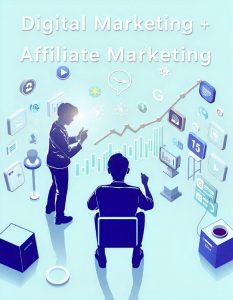What Is Cost-Effectiveness?
In any business, one of the most critical factors for long-term success is managing costs efficiently. Whether you’re running a small startup or a large corporation, the concept of cost-effectiveness plays a central role in determining how well you can sustain growth, improve profitability, and compete in the marketplace. But what exactly does it mean for something to be cost-effective, and how can businesses leverage this principle to optimize their operations?
Affiliate Marketing for Remote Workers: How to Start Earning Commissions from Your Digital Presence
Cost-Effectiveness
Cost-effectiveness refers to achieving the best possible outcome for the least amount of money. In business terms, this means utilizing resources (money, time, manpower, etc.) in a way that maximizes results while minimizing costs. It’s about finding the balance between quality and price—getting the most value from every dollar spent without sacrificing the quality of your products or services.
Cost-effectiveness doesn’t always mean choosing the cheapest option. Instead, it’s about making smart, informed decisions that lead to the highest return on investment (ROI) or best results, whether that’s in terms of customer satisfaction, revenue generation, or operational efficiency.
How To Make Money With The Moniepoint Bank App
Why Is Cost-Effectiveness Important?
- Maximizing Profitability The more cost-effective your operations are, the more profitable your business becomes. By reducing unnecessary expenses and optimizing your use of resources, you can increase your profit margins without having to raise prices or compromise on quality. Profitability is the lifeline of any business, and cost-effectiveness helps ensure you’re making the most of your investments.
- Competitive Advantage In a competitive market, cost-effective businesses are often able to offer better prices, higher-quality products, or more personalized services than their competitors. This gives them a distinct advantage, attracting more customers and enabling them to grow market share.
- Sustainability Cost-effectiveness also plays a vital role in ensuring long-term sustainability. Businesses that manage their costs well are better equipped to weather economic downturns, adjust to changes in the market, and scale operations when the time is right. Poor cost management, on the other hand, can quickly lead to financial strain, debt, or even closure.
- Resource Allocation Every business has limited resources, whether it’s budget, time, or workforce. By focusing on cost-effective strategies, businesses can ensure that resources are allocated where they can make the most impact. This helps avoid waste and inefficiency, ensuring the business is running as lean and productive as possible.
Affiliate Marketing with Us – Sell our Digital Products as an affiliate marketer
How to Apply Cost-Effectiveness in Business
Cost-effectiveness can be applied to virtually every aspect of a business, from production and operations to marketing and customer service. Below are several key areas where businesses can focus on achieving cost-effectiveness:
1. Operations and Production
For businesses that produce goods or services, operations are a major cost driver. Optimizing production processes, reducing waste, and improving supply chain management can lead to significant cost savings. Here’s how:
- Lean Manufacturing: Implement lean production practices to eliminate waste, reduce lead times, and improve efficiency. This may involve streamlining processes, improving inventory management, or adopting just-in-time (JIT) production techniques.
- Energy Efficiency: Reducing energy consumption is another cost-effective measure. For example, using energy-efficient machinery, optimizing factory layout, or utilizing renewable energy sources can significantly lower utility bills over time.
- Outsourcing: In some cases, outsourcing specific tasks or production processes can be more cost-effective than handling everything in-house. For instance, contracting a specialized manufacturing firm might save you money on equipment, labour, and maintenance costs.
2. Marketing
Marketing is another area where businesses can benefit from cost-effectiveness, especially in the digital age. Traditional advertising can be expensive, but many cost-effective digital marketing strategies can produce excellent results.
- Content Marketing: Creating and sharing valuable content through blogs, social media, and email campaigns is a low-cost yet highly effective way to attract and engage customers. Content marketing provides long-term value by improving brand awareness and search engine rankings.
- Social Media Marketing: Instead of spending large amounts on traditional ads, businesses can use social media platforms to engage directly with their audience. Organic social media marketing can be very cost-effective, especially when combined with a paid strategy that targets specific demographics.
- Pay-Per-Click (PPC) Advertising: Platforms like Google Ads and Facebook Ads allow businesses to run highly targeted ad campaigns. With PPC, you only pay when someone clicks on your ad, making it a cost-effective way to drive traffic and conversions, especially when managed carefully.
- Email Marketing: Email campaigns are incredibly cost-effective, allowing businesses to directly reach their customers at a very low cost per contact. With automation tools, you can easily send personalized emails at scale, helping to nurture leads and retain customers without incurring significant costs.
3. Human Resources
Human resources can be a significant expense for any business, but there are ways to manage HR costs while still maintaining a productive workforce:
- Hiring Smart: Instead of constantly expanding your team, consider outsourcing tasks, hiring part-time employees, or bringing in contractors for short-term projects. This allows you to access expertise without the long-term commitment and overhead of full-time staff.
- Employee Retention: Hiring and training new employees is expensive. Focus on retaining your top talent by offering competitive benefits, flexible work arrangements, and opportunities for professional development. A strong company culture also goes a long way in reducing turnover, which helps cut down on hiring and training costs.
- Automation and Technology: By automating repetitive administrative tasks (e.g., payroll, HR management, scheduling), you can save both time and money. Investing in HR software allows you to streamline processes and focus your team’s time on more strategic tasks.
4. Customer Service
Customer service is crucial for business success, but it doesn’t have to be a huge expense. Here’s how you can improve customer satisfaction while keeping costs in check:
- Self-Service Options: Many customers prefer to find answers on their own. By offering self-service tools like a comprehensive FAQ section or a chatbot on your website, you can reduce the number of support tickets and free up your customer service team to handle more complex issues.
- Automation Tools: Using customer service automation, like automated follow-up emails, can ensure that customers feel valued and supported without requiring additional human resources. These tools can handle routine tasks such as order confirmations or support ticket acknowledgements, freeing up your team’s time.
- Feedback Systems: Regularly collecting feedback helps you identify areas for improvement in your products or services. This allows you to address issues before they escalate, potentially saving money on refunds, returns, or lost customers.
How to Earn Money Online – The Ultimate Guide to Financial Freedom
Cost-effectiveness is an essential factor for any business that aims to maximize its resources, grow sustainably, and remain competitive. Whether it’s through optimizing operations, using more efficient marketing strategies, or streamlining customer service, businesses that focus on cost-effectiveness are more likely to thrive in the long run.
Achieving cost-effectiveness doesn’t mean sacrificing quality. It’s about making smart, strategic decisions that allow your business to achieve better outcomes with fewer resources. By regularly evaluating your business operations and finding opportunities to improve efficiency, you can ensure that your business continues to grow while maintaining a healthy bottom line.
Top Free Digital Marketing Online Courses to Boost Your Skills (Get List And Websites)
Subscribe to Safegate World for daily updates.
Check Out Our Premium Services
To Advertise, Advertise Your Affiliate Links on Safegateworld.com
Become a Digital Marketer – Your Complete Guide with 500 Digital Marketing Sites To Start Your Career Immediately!
Related Articles
Can Digital Marketing Make You Rich?
Digital Marketing and Affiliate Marketing
What Is Search Engine Optimization (SEO)?
Pay-Per-Click (PPC) Advertising














